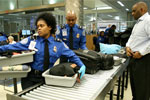
TSA on the Run
- By Ralph C. Jensen
- Aug 01, 2011
Have you been to an airport lately? The security
business is booming, and TSA agents are
out in full splendor, screening passengers left
and right. Nobody gets by the security agents staffing
the front gates.
Well, almost nobody.
On June 25, federal agents questioned a Nigerian
man after he successfully flew from New York to Los
Angeles. They arrested him four days later as he was
attempting to fly from Los Angeles to Atlanta. Problem
was, he didn’t have a valid boarding pass for either
flight.
How did he get past security? You and I always
have to show a valid boarding pass and proper government
identification to get past security, much less
board the airplane. Olajide Oluwaseun Noibi swept
past security at JFK International Airport on June 24
and successfully boarded Virgin America flight 415.
Even more suspicious was that the boarding pass was
not in his name and it was for a June 23 flight.
Something is clearly not quite right here—but it
gets even better. Neither the airline nor TSA noticed
that his ID was a University of Michigan student
card—and that the name on it did not match the
name on his boarding card.
By now, you’ve probably heard the story, but what
you may not know is that the only reason this guy was
caught was because he was sitting in the wrong seat
and an airline attendant asked him for his ticket and
identification in mid-flight.
The FBI met Noibi at LAX after his first run-in,
where they interviewed and then released him, finding
that he didn’t pose much of a threat even though
he was in a secure area without proper identification.
When he was discovered trying to board another
aircraft, again with a faulty boarding pass, he was
stopped. He had 10 more expired boarding passes in
his possession, belonging to other people.
It’s an interesting story, and it casts a pall on TSA,
but remember: TSA isn’t the enemy; al Qaeda is.
Meanwhile, however, officers felt compelled to
pat down a disabled, 95-year-old leukemia patient
at Northwest Florida Regional Airport. TSA agents
made it abundantly clear that the lady would not be
able to board her flight home to Michigan until her
adult diaper was inspected.
Seriously? There’s no way on earth this lady should
have been subjected to this kind of treatment. While
TSA officials say they work to resolve issues in a respectful
manner, they failed miserably in this instance.
This incident comes on the heels of additional
screening incidents involving small children.
In April, there was public outrage over a video
that showed a 6-year-old girl getting the official TSA
pat-down at Louis Armstrong International Airport
in New Orleans. She was patted down because
she moved during the electronic screening, causing a
blurry image.
How dare that 6-year-old act her age.
The incident fueled enough outrage that the government
has made a change in policy for patting
down children. Yet in May, TSA screeners were criticized
again after a photograph was published of them
working over a baby.
The photograph, taken at Kansas City International
Airport after the baby’s stroller set off an alert,
gained worldwide attention. Kansas City pastor Jacob
Jester captured the image on his cell phone and
later posted it on his Twitter account. Jester said he
noticed the mother and baby behind him because he
has a son about the same age.
“My thinking was, this is an extreme measure,” he
said. “I wouldn’t want this to happen to my own son.”
Of course, TSA has reviewed the screening of
this family and found that because the child’s stroller
alarmed during an explosives check, a closer look
was warranted. TSA said its officers followed proper
procedure and that the family was cooperative and on
their way to their gate rather quickly.
“I’m not out to embarrass the TSA,” Jester said.
“But I do believe there has to be a line drawn. I do
not believe that an 8-month-old constitutes a security
threat.”
These are only a few of the embarrassing moments
in the life of the Transportation Security Administration.
The agency deserves all the respect accorded to
a group of people just trying to do their jobs the best
way possible. Their jobs are to keep the flying public
safe and secure, and, regardless of how it sometimes
feels, it’s important to remind ourselves that they are
not the enemy. It is, however, situations such as this
that prompt the public to feel a little less than secure,
and a little more used. It also means a face-to-face
visit to Congress by agency officials.
Testifying before the Senate Homeland Security
and Governmental Affairs Committee, TSA boss
John Pistole said his agency is working on policy
changes for screening children without resorting
to invasive pat-downs. Screeners have now been instructed
to use a modified pat-down for children ages
12 and younger.
Pistole told the Senate committee, “We need to use
common sense.”
Historically, that is often what is missing during
times that try men’s souls.
This article originally appeared in the August 2011 issue of Security Today.